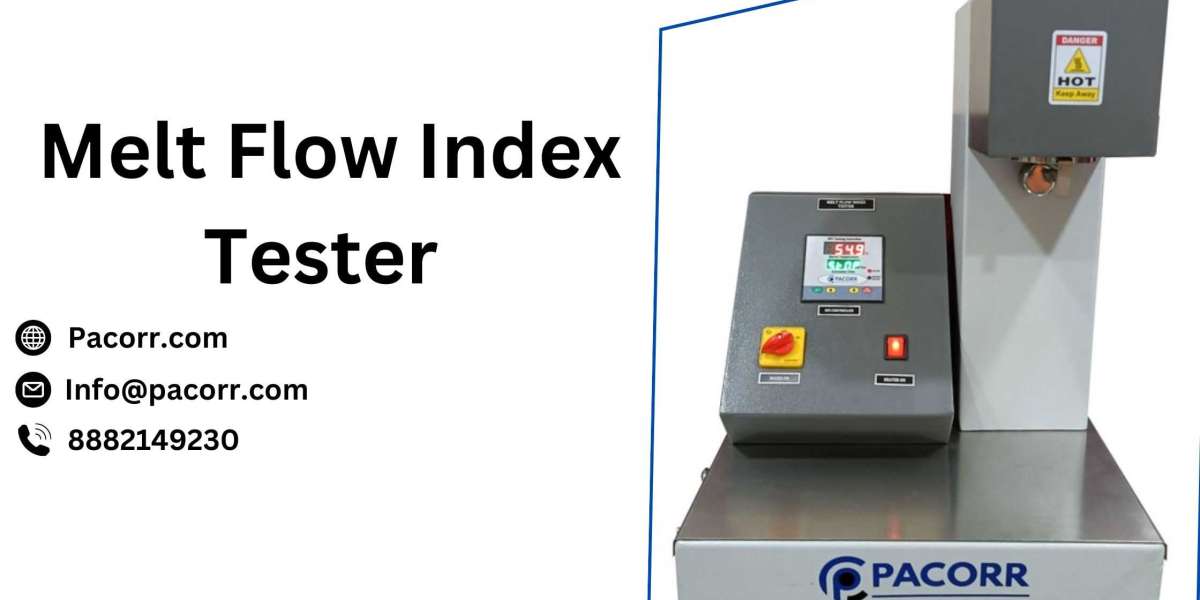At Pacorr Testing Instruments, we understand the critical role this instrument plays in the industry, helping manufacturers ensure their products meet stringent quality requirements.
What is a Melt Flow Index Tester?
The Melt Flow Index Tester, also known as the Melt Flow Rate Tester, is a specialized instrument used to measure the flow rate of molten plastic materials. This flow rate, commonly referred to as the Melt Flow Index Testing, is a crucial indicator of the material’s viscosity when in a molten state. The MFI is measured in grams per 10 minutes (g/10 min) and provides insights into the polymer’s molecular structure, which directly impacts its processing characteristics and final applications.
Why is Melt Flow Index Important?
The Melt Flow Index is a critical parameter for several reasons:
- Material Selection: Different plastic products require different levels of flowability. A polymer with a low MFI might be ideal for creating strong, durable parts, while a higher MFI could be better suited for producing thin, intricate components. By understanding the MFI, manufacturers can select the most appropriate material for their specific application.
- Process Optimization: Knowing the MFI helps manufacturers fine-tune their production processes. For instance, in injection molding or extrusion, the ease with which the polymer flows can significantly impact cycle times and the quality of the finished product. Consistent MFI measurements allow for better control over the manufacturing process, leading to more efficient production and less material waste.
- Quality Control: Regular testing of the MFI ensures that the polymer used in production remains within the desired specifications. This is vital for maintaining consistent product quality, reducing the risk of defects, and ensuring that the final product meets both regulatory and customer standards.
- Predicting Performance: The MFI can also give insights into the mechanical properties of the plastic, such as tensile strength, impact resistance, and elongation at break. Understanding these correlations allows manufacturers to predict how the material will perform in its intended application, ensuring that the final product meets all required performance criteria.
How Does the Melt Flow Index Tester Work?
The operation of a Melt Flow Index Tester Price is straightforward yet precise. A sample of the polymer is heated in a barrel to a specified temperature. Once the polymer reaches the required molten state, a standardized weight is applied to extrude the material through a die. The amount of polymer that flows out over a set period (usually 10 minutes) is weighed, and this measurement is recorded as the Melt Flow Index.
The conditions under which this test is conducted, such as temperature, weight, and die dimensions, are standardized according to international testing standards like ASTM D1238 and ISO 1133. This standardization ensures that the results are reliable, repeatable, and comparable across different testing environments.
Applications of the Melt Flow Index Tester
The Melt Flow Teste is an invaluable tool across a wide range of industries, including:
- Automotive: Ensuring that plastic components used in vehicles meet strict safety and performance standards.
- Packaging: Evaluating the quality of materials used in everything from flexible films to rigid containers, ensuring they can withstand the demands of transportation and storage.
- Medical Devices: Verifying the reliability and safety of plastics used in critical medical applications, where material consistency is non-negotiable.
- Consumer Goods: Ensuring that everyday products, from toys to electronics, are manufactured to the highest quality standards.
Choosing the Right Melt Flow Index Tester
When selecting a Melt Flow Index Tester, it’s essential to consider factors such as:
- Temperature Range: Ensure the tester can reach the required temperatures for the materials you are testing.
- Load Options: The ability to apply different weights is crucial for testing a variety of polymers.
- Ease of Use: Features like automated sample cutting and pre-programmed test conditions can save time and reduce the risk of operator error.
- Compliance with Standards: Make sure the tester meets all relevant international standards to ensure accuracy and reliability.
Conclusion
At Pacorr Testing Instruments, we are committed to providing high-quality, reliable testing equipment that helps manufacturers maintain the highest standards of quality control. The Melt Flow Index Testingis a critical tool in this process, enabling manufacturers to optimize their production processes, select the right materials, and ensure consistent product quality.
For more information on the Melt Flow Index Tester and how it can benefit your manufacturing processes, visit Pacorr Testing Instruments.








